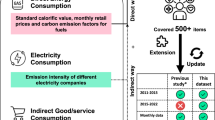Abstract
Understanding the spatial variability of household carbon emissions is necessary for formulating sustainable and low-carbon energy policy. However, data on household carbon emissions is limited in China, the world’s largest greenhouse gases emitter. This study quantifies and maps household carbon emissions in Shanghai using a city-wide household survey. The findings reveal substantial spatial variability in household carbon emissions, especially in transport-related emissions. Low emission clusters are founded in Hongkou, Xuhui, Luwan, Jinshan, and Fengxian. High emission clusters are located in Jiading and Pudong. Overall, the spatial pattern of household carbon emissions in Shanghai is donut-shaped: lowest in the urban core, increasing in the surrounding suburban areas, and declining again in the urban fringe and rural regions. The household emissions are correlated with a number of housing and socioeconomic factors, including car ownership, type of dwelling, size of dwelling, age of dwelling, and income. The findings underscore the importance of a localized approach to low-carbon policymaking and implementation.
Similar content being viewed by others
References
Shammin M R, Herendeen R A, Hanson M J, Wilson E J. A multivariate analysis of the energy intensity of sprawl versus compact living in the US for 2003. Ecological Economics, 2010, 69(12): 2363–2373
Zegras P C. The built environment and motor vehicle ownership and use: Evidence from Santiago de Chile. Urban Studies (Edinburgh, Scotland), 2010, 47(8): 1793–1817
Liu L C, Wu G, Wang J N, Wei YM. China’s carbon emissions from urban and rural households during 1992–2007. Journal of Cleaner Production, 2011, 19(15): 1754–1762
McNeil M A, Letschert V E. Future air conditioning energy consumption in developing countries and what can be done about it: the potential of efficiency in the residential sector. 2014-05, http://www.eceee.org/library/conference_proceedings/eceee_Summer_-Studies/2007/Panel_6/6.306/paper
Cao X, Huang X. City-level determinants of private car ownership in China. Asian Geographer, 2013, 30(1): 37–53
Zheng S, Wang R, Glaeser E L, Kahn M E. The greenness of China: household carbon dioxide emissions and urban development. Journal of Economic Geography, 2011, 11(5): 761–792
Peters G P. Carbon footprints and embodied carbon at multiple scales. Current Opinion in Environmental Sustainability, 2010, 2(4): 245–250
Wiedenhofer D, Lenzen M, Steinberger J K. Energy requirements of consumption: Urban form, climatic and socio-economic factors, rebounds and their policy implications. Energy Policy, 2013, 63: 696–707
Druckman A, Jackson T. Household energy consumption in the UK: A highly geographically and socio-economically disaggregated model. Energy Policy, 2008, 36(8): 3177–3192
Druckman A, Jackson T. The carbon footprint of UK households 1990–2004: a socio-economically disaggregated, quasi-multi-regional input-output model. Ecological Economics, 2009, 68(7): 2066–2077
Naess P. ‘New urbanism’ or metropolitan-level centralization? A comparison of the influences of metropolitan-level and neighborhood-level urban form characteristics on travel behavior. Journal of Transport and Land Use, 2011, 4(1): 25–44
VandeWeghe J R, Kennedy C. A spatial analysis of residential greenhouse gas emissions in the Toronto census metropolitan area. Journal of Industrial Ecology, 2007, 11(2): 133–144
Wilson J, Spinney J, Millward H, Scott D, Hayden A, Tyedmers P. Blame the exurbs, not the suburbs: exploring the distribution of greenhouse gas emissions within a city region. Energy Policy, 2013, 62: 1329–1335
Ye H, Wang K, Zhao X, Chen F, Li X, Pan L. Relationship between construction characteristics and carbon emissions from urban household operational energy usage. Energy and Building, 2011, 43(1): 147–152
Liu R. Energy consumption and energy intensity in multi-unit residential buildings (MURBs) in Canada. CBEEDAC 2007-RP-04. Canadian Building Energy End-Use Data and Analysis Centre, Edmonton, 2007
Bird S, Hernández D. Policy options for the split incentive: increasing energy efficiency for low-income renters. Energy Policy, 2012, 48: 506–514
Lo K. China’s low-carbon city initiatives: the implementation gap and the limits of the target responsibility system. Habitat International, 2014, 42: 236–244
Kwan C L. Influence of local environmental, social, economic and political variables on the spatial distribution of residential solar PV arrays across the United States. Energy Policy, 2012, 47: 332–344
Girod B, de Haan P. More or better? A model for changes in household greenhouse gas emissions due to higher income. Journal of Industrial Ecology, 2010, 14(1): 31–49
Kennedy E H, Krahn H, Krogman N T. Egregious emitters: disproportionality in household carbon footprints. Environment and Behavior, 2014, 46(5): 535–555
Liu W, Spaargaren G, Heerink N, Mol A P, Wang C. Energy consumption practices of rural households in north China: basic characteristics and potential for low carbon development. Energy Policy, 2013, 55: 128–138
Li L, Chen C, Xie S, Huang C, Cheng Z, Wang H, Wang Y, Huang H, Lu J, Dhakal S. Energy demand and carbon emissions under different development scenarios for Shanghai, China. Energy Policy, 2010, 38(9): 4797–4807
Wang Y, Ma W, Tu W, Zhao Q, Yu Q. A study on carbon emissions in Shanghai 2000-2008, China. Environmental Science & Policy, 2013, 27: 151–161
Glaeser E L, Kahn M E. The greenness of cities: carbon dioxide emissions and urban development. Journal of Urban Economics, 2010, 67(3): 404–418
Author information
Authors and Affiliations
Corresponding author
Rights and permissions
About this article
Cite this article
Yang, S., Wang, C., Lo, K. et al. Quantifying and mapping spatial variability of Shanghai household carbon footprints. Front. Energy 9, 115–124 (2015). https://doi.org/10.1007/s11708-015-0348-8
Received:
Accepted:
Published:
Issue Date:
DOI: https://doi.org/10.1007/s11708-015-0348-8




